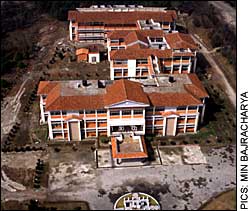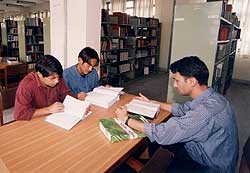 Political slogans welcome you at the main entrance of Tribhuvan University. Different student unions, teacher associations and employee unions inclined towards various political ideologies vie for your attention, claiming to protect the rights of one group or another, and saying that they alone can safeguard university interests. The high-sounding claims are the most obvious indicator of what underlies any discussion amongst TU functionaries about the development of the university, its academic obligations, and achievement-there's too much politics on campus.
Political slogans welcome you at the main entrance of Tribhuvan University. Different student unions, teacher associations and employee unions inclined towards various political ideologies vie for your attention, claiming to protect the rights of one group or another, and saying that they alone can safeguard university interests. The high-sounding claims are the most obvious indicator of what underlies any discussion amongst TU functionaries about the development of the university, its academic obligations, and achievement-there's too much politics on campus. Under the partyless Panchayat regime, TU served as a forum for intellectual and ideological debate. The student unions camouflaged a political movement that surmounted ideological restrictions and made possible Nepal's first referendum in 1979, which allowed the Nepali populace to choose between a multi-party system and the Panchayat. Today, well after the restoration of democracy, propaganda and politics are still as much part of TU's offerings as coursework and degrees. 1990. Political parties still find TU fertile ground to train young people on their ideologies, while students use it as a launch pad for their budding political careers. The recent success stories, such as that of former MP Jaganath Khatiwada, and former state minister NP Saud, who cut their political teeth in TU, have encouraged other students to use student unions as political platforms. "There is no harm in having a political ideology. Once elected, we concentrate on student rights and the well-being of the university," claims Dipendra Acharya, who was elected vice president of the Nepal Student Union from a Nepali Congress-affiliated union.

The professors and bureaucrats at TU are not much better. Equally involved in politics and divided along ideological lines, they contest their own elections under the auspices of established political entities. As for the administrative employees, in the last elections to their professional union, the main fight was between the familiar symbols of the tree and the sun-the Nepali Congress and the CPN-UML. As a result, says Madhav Koirala, a TU administrator, "all administrative decisions are politicised, and chances are slim that all decisions serve the best interests of TU."
 TU was established in 1959 as Nepal's first university under the Tribhuvan University Act with royal patronage. It was first part of the larger drive to modernise education in Nepal. The physical infrastructure was constructed at the present location in Kirtipur only in 1966. Three years later, in 1972, both public and private colleges across the country were declared constituent campuses f TU under the National Education System Plan. Only much later, in the early 1990s, did Nepal hit upon the idea of multiple universities.
TU was established in 1959 as Nepal's first university under the Tribhuvan University Act with royal patronage. It was first part of the larger drive to modernise education in Nepal. The physical infrastructure was constructed at the present location in Kirtipur only in 1966. Three years later, in 1972, both public and private colleges across the country were declared constituent campuses f TU under the National Education System Plan. Only much later, in the early 1990s, did Nepal hit upon the idea of multiple universities. Separate National Education Commissions in 1993 and 1998 recommended the establishment of four regional universities in the eastern, western, mid-western and far western development regions by integrating TU constituent campuses and private affiliated campuses, and then specified what exactly it meant by the 'regional and multi-university' concept. Today, there are five full-fledged universities in Nepal, and efforts are on to create technical universities.
But TU continues to face the problems that the multi-university concept was supposed to deal with. The Purbanchal University and Pokhara University were established by two separate parliamentary Acts in 1995 and 1997 to be developed as regional universities in eastern and mid-western regions. The governing acts clearly specify that the TU constituency and affiliated campuses in the respective regions should gradually be made part of the new institutions. The importance of this process was again emphasised in the 1999/2000 budget policy.
The concept however never really took off mostly due to resentment at TU over the perceived diminishing of the authority of the institution due to redistribution of its powers. Since TU's charter states that it is an autonomous, self-administered institution, the university felt that the committee formed by the government with the National Planning Commission to facilitate the handing over of its regional satellites to the new universities was interference.
As a result, TU continues to be overburdened with students and mired in administrative complications. This academic year, approximately 143,000 students-90 percent of all tertiary education students-study at TU campuses. Each year approximately 48,000 graduate from high school, and an estimated 80 percent of them opt for higher education. Despite the government having adopted a 12-year school system, popularly known as Plus Two, to replace TU's proficiency certificate levels with the higher secondary education system, most students still join TU campuses after passing the SLC examination. Phasing out the intermediate levels was expected to reduce TU's student load by almost 30 percent. This could have allowed TU to spend more of its constrained funds on academic activities. But TU continues to spend as much as 80 percent of its government subsidy on salaries and administrative costs.
 "We have continued the intermediate levels on humanitarian grounds, as the private Plus Two schools are unaffordable for most school graduates," explains Naveen Prakash Jung Shah, vice-chancellor of TU. But, he adds, "Political commitment is needed to phase out intermediate levels, unless affordable, government funded Plus Two schools are established, it is not possible."
"We have continued the intermediate levels on humanitarian grounds, as the private Plus Two schools are unaffordable for most school graduates," explains Naveen Prakash Jung Shah, vice-chancellor of TU. But, he adds, "Political commitment is needed to phase out intermediate levels, unless affordable, government funded Plus Two schools are established, it is not possible." The government had planned to gradually phase out intermediate levels by 2001. The private sector responded enthusiastically and by the fiscal year 2001/02, 775 Plus Two schools were running, but students especially from rural areas continue to throng TU campuses for intermediate levels mostly for economic reasons-a student in TU campuses can complete the intermediate level courses for about Rs 4000, while the average expense for the Plus Two years is about Rs 60,000. In addition, these private colleges are concentrated only in urban areas.
Add to this a drop in quality. Teachers at the Plus Two level-like teachers at TU-are required to have Masters' degrees, as a result of which a large number of teachers are moving to better-paying private school jobs. The recent move to expand two-year Bachelor's courses to three years has also led to a shortage of teachers at TU campuses, which has directly affected teaching hours, and quality. Though the academic calendars allocate 180 lecture hours for each paper, in the last academic year students appeared for the exams with only about 100 hours of lectures. "There are no mechanisms to recognise the contributions of devoted teachers, or, conversely, check that university rules are being followed," says Professor Tri Ratna Manandhar, a TU dean. On average, less than 25 percent of students who appear for university exams pass.
 Shortage of funds and misallocation of what is available is another reason for TU's troubles and the declining quality of education there. TU generates only 15 percent of its expenditure from its own sources, 85 percent is covered with government subsidy and foreign aid, though this has been dropping of late. This academic year TU needs an estimated Rs. 2.24 billion to run the 27 different degrees it offers, but the government has announced a grant of only Rs 1.56 billion. Under pressure from the student unions TU has not been able to revise its rock-bottom fee structure. Recently, Kathmandu's Padma Kanya College was shut down by the Nepal Student Union when it tried to raise fees. Presently, a TU Master's student pays only Rs 70 a month for tuition fees.
Shortage of funds and misallocation of what is available is another reason for TU's troubles and the declining quality of education there. TU generates only 15 percent of its expenditure from its own sources, 85 percent is covered with government subsidy and foreign aid, though this has been dropping of late. This academic year TU needs an estimated Rs. 2.24 billion to run the 27 different degrees it offers, but the government has announced a grant of only Rs 1.56 billion. Under pressure from the student unions TU has not been able to revise its rock-bottom fee structure. Recently, Kathmandu's Padma Kanya College was shut down by the Nepal Student Union when it tried to raise fees. Presently, a TU Master's student pays only Rs 70 a month for tuition fees. Complicating matters is the fact that the performance of departments and the demand for a particular discipline is not taken into account when allocating funding. As a result, for instance, the history faculty has 21 teachers for the seven students of the 35 enrolled who actually attend classes on a regular basis. The Hindi and Sanskrit departments only admitted five students each, of which only two attend, but their budget has not been significantly changed in recent years.
"We don't know yet how will we manage the fund gap created by the cut in the government subsidy," says Yogendra Shakya, chief of the TU's Economic Administration Division. Two years ago the division recommended a 100 to 150 percent increase in tuition fees, but nobody within the TU machinery is hopeful that anything like this will happen anytime soon. The unions, as they know, are too powerful.


